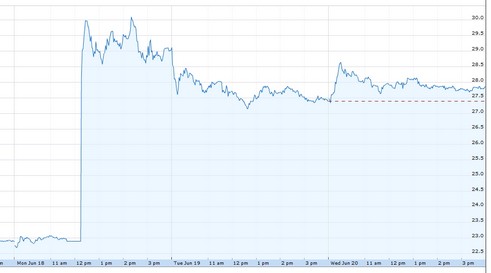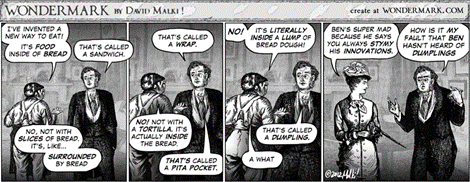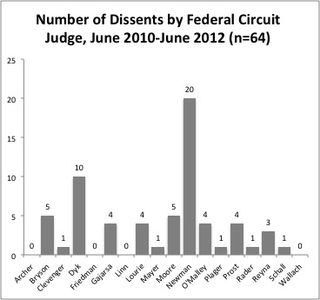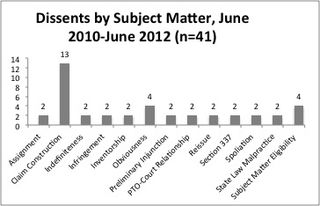In re Bill of Lading, No. 2010-1493 (Fed. Cir. 2012)
by Dennis Crouch
In a split decision, the Federal Circuit has partially reversed a lower court’s dismissal for failure to state a claim. Writing for the majority, Judge O’Malley made an important doctrinal distinction between when an offer to sell constitutes direct infringement as compared with indirect infringement. The decision also highlights the tension between recent Supreme Court pleadings cases (Iqbal & Twombly) and the bare-bones form pleadings (Form 18) found in the Federal Rules. Here, the court held a complaint following the Form 18 necessarily satisfies the notice pleading requirements but that Form 18 does not apply to allegations of indirect infringement. The result of this case will likely be to further raise the pleading requirements for indirect infringement cases. Judge Newman dissented — arguing that a Form 18 complaint should normally be deemed insufficient to provide sufficient notice to alleged infringers.
+ + + + +
R+L Carriers is both the plaintiff and DJ defendant in a merged multi-party suit involving a host of alleged infringers. The lawsuit centers on R+L’s U.S. Patent No. 6,401,078. The patent is directed to a system for creating bill-of-lading for individual packages. Basically, the invention directs folks to scan documentation data that is on a package on-board a transporting vehicle; sending that scanned “image” to a remote processing center; and then preparing a loading manifest that directs folks what to do with the package next (such as load it on another vehicle).
Failure to State a Claim: The district court dismissed the lawsuit for failure to state a claim under Fed. R. Civ. Pro. R. 12(b)(6). Patent cases are begun with the filing of a complaint in federal court. Federal Courts follow a “notice pleading” standard that traditionally only requires a limited amount of information in the complaint itself. However, in a pair of recent cases, the Supreme Court raised the standard to require that plaintiffs recite sufficient facts in the complaint to make the case plausible. Bell Atlantic Corp. v. Twombly, 550 U.S. 544 (2007) and Ashcroft v. Iqbal, 556 U.S. 662 (2009). The “plausible” standard requires more than showing that liability is merely possible or conceivable. However, a “plausible” is not necessarily “probable.” Thus, Twombly and Iqbal raise the potential that the pleadings will better filter meritless cases. However, many losing cases will still survive motions on the pleadings.
Form 18 Complaint: Despite this seeming increased standard, the rules of civil procedure include a loophole through a standard patent complaint known as Form 18. Form 18 is a threadbare complaint and contains only five sentences that make-up the body of the complaint.
1. This action arises under a federal statute, <_____>.
2. On <Date>, United States Letters Patent No. <__________________> were issued to the plaintiff for an invention in an <Electric Motor>. The plaintiff owned the patent throughout the period of the defendant's infringing acts and still owns the patent.
3. The defendant has infringed and is still infringing the Letters Patent by making, selling, and using <Electric Motors> that embody the patented invention, and the defendant will continue to do so unless enjoined by this court.
4. [If Applicable] The plaintiff has complied with the statutory requirement of placing a notice of the Letters Patent on all electric motors it manufactures and sells and has given the defendant written notice of the infringement.
Therefore, the plaintiff demands: (a) a preliminary and final injunction against the continuing infringement; (b) an accounting for damages; and (c) interest and costs.
In Twombly, the Supreme Court recognized that there may be some conflict between the form complaints and the higher standards suggested by the Court. In those situations, the Court has been clear that the forms control. Thus, the Federal Circuit here held that pleadings fitting within Form 18 cannot be held insufficient to state a claim for patent infringement. In particular, the court noted that a plaintiff need not “plead facts establishing that each element of an asserted claim is met” or “even identify which claims it asserts are being infringed.”
Indirect Infringement Not Covered by Form 18*: When examining Form 18, the court made an important distinction between complaints for direct infringement and indirect infringement. Form 18 is focused on the actions of “making, selling, and using” the patented invention. These are forms of direct infringement. The Federal Circuit here held that the Form 18 only applies to allegations of direct infringement and not indirect infringement. And thus, indirect infringement must be pled in a way that meets the Twombly standard. One exception here is that the court noted that pleading indirect infringement does not require identifying specific customers who perform the underlying direct infringement as long as the facts pled allow an inference of underlying direct infringement. Note – the court did not specifically decide whether Form 18 is sufficient when the direct infringement is in some form other than making, selling, or using (such as offering for sale).
Contributory Infringement: Section 271(c) of the Patent Act creates contributory infringement liability for anyone who sells or offers to sell a component for use in practicing a patented process and that component is material to practicing the invention, has no substantial non-infringing uses, and is known by the party “to be especially made or especially adapted for use in an infringement of such patent.” 35 U.S.C. § 271(c). Here, R+L’s complaints failed to specifically allege that the accused components (scanning equipment) lacked substantial non-infringing uses. On appeal, the Federal Circuit held that the complaint must include that allegation. Thus, these claims were dismissed.
Inducing Infringement: Section 271(b) of the Patent Act creates liability for inducing infringement and includes a mens rea requirement that the alleged inducer have “knowledge that the induced acts constitute patent infringement.” Here, the R+L did plead those specific elements, but the district court dismissed the claim after finding the required inferences of knowledge to be “implausible and unreasonable.” On appeal, the Federal Circuit reversed that finding – holding that a plaintiff need not prove its case in the complaint and that at the pleading stage all reasonable inferences must be determined in favor of the non-moving party.”
Before turning to the individual amended complaints and the specific allegations therein, we note a flaw that pervades the district court’s assessment of R+L’s allegations of induced infringement—its failure to draw all reasonable inferences in favor of the non-moving party. Twombly did not alter this basic premise. Nothing in Twombly or its progeny allows a court to choose among competing inferences as long as there are sufficient facts alleged to render the non-movant’s asserted inferences plausible.
As an example, the complaint identified advertising from one of the defendants that suggested an infringing use and alleged that the advertisement was distributed after receiving a cease and decisit letter from the patentee. The Federal Circuit found that (and similar allegations against other defendants) to be sufficient under Twombly.
+ + + + +
The implication from this case is that Form 18 should be either (1) eliminated or (2) re-written. I suggest elimination. Patent litigators know how to draft a complaint and it is not very difficult to provide a sufficient level of detail and factual allegation in a complaint or counterclaim. For cases involving patents with excessive claims (25+) I would suggest that simply identifying the patent does not provide sufficient notice. Rather, the complaint should also identify the claims alleged to be infringed.





